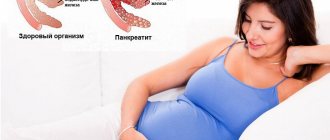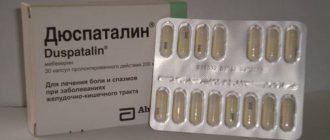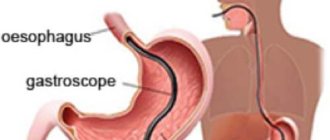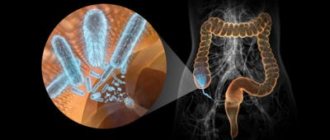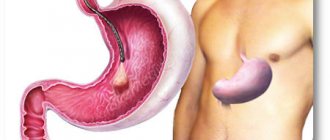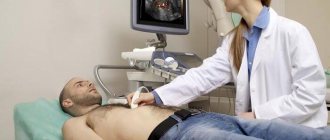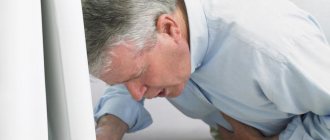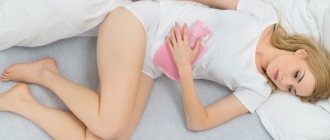Pancreatitis is an inflammatory and degenerative process in the pancreas. Every year the number of people suffering from pancreatitis increases. The symptoms and treatment of this disease directly depend on the severity of the inflammatory process and the severity of damage to the pancreas.
The main victims of pancreatitis most often are people prone to overeating, lovers of fatty foods, and alcohol. Under the influence of certain provoking factors, the production of proteolytic enzymes is activated in the pancreas, which causes inflammatory processes.
Causes of pancreatitis
Most often, in a person suffering from pancreatitis, there are several factors that contributed to its development, which should be established and, if possible, eliminated. 98% of all cases of acute pancreatitis are associated with either alcohol abuse or gallstone disease. For details of the pathological processes occurring in the pancreas during inflammation, as well as additional risk factors for the development of pancreatitis, read the article Causes of pancreatitis.
How to understand what exactly hurts
Pain in the pancreas of the abdomen is one reason to see a doctor. When voicing their symptoms, many do not understand that they have become carriers of a serious disease - pancreatitis.
This pathology has strong symptoms and timely assistance to the patient depends on establishing the correct diagnosis. Pain in the stomach and pancreas is not always this type of disease. These are already the consequences of side effects of other equally dangerous diseases:
- liver diseases;
- kidney disease;
- blockage of the choleretic channels and many others that affected the human pancreas.
To understand how to properly relieve pancreatic pain at home, the correct diagnosis and causes of the disease are established. Therefore, it is necessary to familiarize yourself with some examples of pain syndrome symptoms:
- Pain in the right hypochondrium – problems with the liver.
- Girdle pain, acute attacks radiate to the back or shoulder blade - choleretic problems (inflammation of the gallbladder).
- The initial impulse of pain from the solar plexus goes to the back, cutting pain under the right and left hypochondrium is a sign of pancreatic inflammation. It increases with the body position, lying down; in a sitting position, the syndrome subsides - confirmation of this conclusion.
- Bluishness around the navel, cutting pain in the upper left side of the abdomen and solar plexus - damage to the spleen.
- Periodic stabbing - cutting pain throughout the abdomen, diarrhea or constipation, blood drops in the stool - a disturbance in the functioning of the intestines.
- Aching pain in the left side of the abdomen with attacks of vomiting - gastric syndrome.
- Lower right part of the abdomen, acute pain radiating to the navel - appendicitis.
What is the pancreas and its structure? The gland is the digestive organ of the body. Its location in the human body is behind the stomach, the weight of the organ is no more than 80 g. The structure of the pancreas has a “head”, “body”, “tail”. The most common and susceptible to pancreatitis is the tail of the gland. What to do when the tail of the pancreas hurts, what are the symptoms of inflammation?
During the inflammatory process in the pancreas, it does not always increase evenly. The most common is an enlargement of the “tail” of the gland. The enlargement obstructs the duct of the splenic vein and subrenal hypertension. What causes the pain syndrome of pancreatitis. What causes this pathology:
- the appearance of stones blocking the duct;
- appearance of a cyst (adenoma);
- inflammatory abscess of the head of the gland;
- pseudocyst;
- duodenitis of the duodenum;
- growths on the intestinal papilla;
- oncological pathologies.
According to statistics, pathology occurs from 3 cases of disease to 1 case of pathology of the tail of the pancreas. The main threat is the possible development of tail cancer. The peculiarity of inflammation is the difficulty of diagnosis, because the physiological structure of the body makes it possible to check only through the spleen or left kidney, and this is a difficult undertaking.
Symptoms of inflammation of the tail of the pancreas:
- dull aching pain in the back and solar plexus;
- pain syndrome manifests itself in the heart;
- relieves partial pain symptoms by bending forward;
- lack of appetite;
- loose stools;
- nausea often ends with severe bouts of vomiting;
- body temperature reaches 38*C, 40*C.
Symptoms of acute pancreatitis
The pancreas is not a very large organ, however, it performs the most important functions in the human body, the most important of which are the secretion of food enzymes for normal digestion and the production of insulin, the deficiency of which leads to such a serious disease as diabetes. What happens when the gland becomes inflamed? During the period of acute pancreatitis, symptoms develop as in severe poisoning. Enzymes produced by the pancreas are retained in it or its ducts and begin to destroy the gland itself, and when they enter the blood they cause symptoms of general intoxication:
Fast food is one of the main enemies of the pancreas
- Pain . This is the most pronounced symptom; pain with pancreatitis is usually very intense, constant, the nature of the pain is described by patients as cutting, dull. If medical care and pain relief are not provided in a timely manner, the patient may experience pain shock. The pain is localized in the pit of the stomach, hypochondrium, either on the right or on the left, depending on the location of the gland lesion; in the case when the entire organ is inflamed, the pain is girdling in nature.
- High temperature, low or vice versa high pressure. With the rapid development of the inflammatory process, the patient’s well-being quickly deteriorates, the temperature may rise to high levels, and blood pressure may decrease or increase.
- Complexion . With pancreatitis, the patient's facial features sharpen, at first the skin becomes pale, and gradually the complexion acquires a gray-earthy hue.
- Hiccups, nausea. Pancreatitis is also characterized by symptoms such as dry mouth, hiccups, belching and nausea.
- Vomit. Attacks of vomiting with bile do not bring relief to the patient. Therefore, at the beginning of the acute period, there is no talk of any food intake; fasting in the case of acute pancreatitis is the main condition for successful further treatment.
- Diarrhea or constipation . Stools in acute pancreatitis are most often foamy, often with a foul odor, with particles of undigested food. Vomiting can also be caused by food eaten (when vomiting gastric contents at the beginning of an attack), then bile appears from the duodenum. However, on the contrary, there are also constipation, bloating, and hardening of the abdominal muscles, which may be the very first signal of an acute attack of pancreatitis.
- Dyspnea. Shortness of breath is also caused by loss of electrolytes through vomiting. The patient is bothered by constant shortness of breath, sticky sweat, and a thick yellow coating appears on the tongue.
- Bloating . The stomach and intestines do not contract during an attack, therefore, upon examination, the doctor detects severe bloating; palpation does not detect tension in the abdominal muscles.
- Blueness of the skin . Blue spots may appear around the navel or on the lower back, giving the skin a marbled tint; in the groin area, the skin color may acquire a blue-green tint. This is explained by the fact that blood from the inflamed gland can penetrate under the skin of the abdomen.
- Yellowness of the sclera and skin. With the sclerosing form of pancreatitis, obstructive jaundice may occur, which appears due to compression of part of the common bile duct by compacted gland tissue.
- With such symptoms of pancreatitis, a person’s condition is worsening every minute; in such cases, one cannot hesitate and should call an ambulance as soon as possible.
Pain and causes of inflammation
So why does the pancreas hurt, and what are the causes of this pathology? Pain in the pancreas occurs to a greater extent with alcohol abuse or inflammatory processes in the gallbladder (urolithiasis).
This risk of pathology accounts for 80% of all visits to medical institutions, according to statistics from the Ministry of Health. True, with the main reasons, there are others that also provoke inflammatory processes in the gland, and there are plenty of them. They will appear in conjunction with pancreatitis, which aggravates the already difficult situation of the patient. So why does the pancreas hurt and factors that provoke an increase in the inflammatory process:
- ulcers;
- duodenitis;
- injuries to the abdominal area and internal organs;
- drug poisoning;
- misuse of drug treatment and abuse of non-prescription pills;
- viral infections, hepatitis of all types and forms;
- helminthic infestations;
- metabolic disease;
- weak immune system;
- vegetative-vascular dystonia;
- heredity to the disease;
- constant stress;
- abuse of alcohol and smoking.
Therefore, before treating pancreatitis, after carrying out diagnostic measures, the primary source of provocation of the pancreas is eliminated first, and only then the symptoms of the disease are relieved. Mostly, attacks of pancreatitis occur at home in the evening, so you need to know how to calm the pancreas while at home. To do this, check out some tips:
- If an attack occurs at home, the victim needs to take a curled up position (embryo) and slightly tilt his torso forward. In this position, the pain will become much quieter for a short period of time, which will make it possible to wait for the ambulance to arrive.
- When the pancreas aches and hurts, you should not apply warm compresses to the painful area. Only cold lotions (including frozen foods) to the site of focal pain and complete rest of the patient are allowed. Cold objects that will be used to relieve the source of pain must be wrapped in a thin cloth to avoid frostbite of the skin area.
- At the time of an attack of pancreatitis and in the next 3 days, food should be completely excluded from the patient’s diet; what is possible is only drinking liquid (still mineral water, decoctions of medicinal herbs, weak tea drink). Drinking liquid will not provoke inflammatory processes and will remove the bulk of toxins and harmful substances from the body.
- After 2-3 days of therapeutic fasting, during the period of complete relief of pain symptoms, it is allowed to eat simple and light food: oatmeal, jelly, boiled or baked vegetables, lean fish and meat.
Cooking should only be done by boiling or baking; food should only be consumed in ground pulp form. Completely avoid salty, sour, bitter, fried and smoked foods. Anything that will provoke a repeated attack and irritation of the pancreas.
Medication methods are used to relieve pain. In case of an acute attack of pancreatitis, the following medications are allowed:
- Baralgin;
- Paracetamol;
- antispasmodic No-shpa;
- Papaverine;
- Mezim, Creon, Festal will help relieve acidity.
It will also help relieve the symptoms of pancreatitis at home using traditional methods of treatment. It is advisable to coordinate all these methods with your doctor in order to avoid individual intolerance to the body and the occurrence of side effects:
- Drink fresh potato juice 30 minutes before meals.
- Taking a decoction of oatmeal.
- Eating peppermint;
- Decoction of rosehip, chamomile, hawthorn.
All these methods require coordination, since some types of products provoke a repeated attack of pancreatitis.
It is also necessary to understand that the disease does not like amateurs and improper treatment. Pancreatitis (inflammation of the pancreas) is an insidious disease that will bring sad results from neglect of health and provoke other side diseases.
Treatment of acute pancreatitis
In case of acute pancreatitis, treatment is possible only in a hospital setting, under the supervision of qualified specialists; this is considered a very dangerous condition. If you suspect acute pancreatitis, you should urgently call an ambulance and the person should be urgently hospitalized.
Sometimes failure to provide medical care in a timely manner can cost a person his life. The first aid that can be provided to a person with an attack of pancreatitis, the symptoms of which are obvious, is to apply cold to the stomach, take an antispasmodic - Na-shpa, Papaverine, as well as refusal to eat any food and bed rest until the ambulance arrives.
The main 3 pillars on which the treatment of acute pancreatitis is based: HUNGER, COLD AND REST
Emergency assistance provided in the Ambulance:
- puncture the vein, drip with saline solution
- antiemetic - metoclopramide (cerucal) 10 mg
- pain reliever - ketorolac
- antisecretory - octreotide (sandostatin) 250 mg or quamatel (omeprazole) 40 mg
In a hospital setting, the following is usually carried out:
- In the hospital, intravenous administration of sodium chloride (saline solution), reopolyglucin + contrical
- Diuretics are used, they prevent swelling of the pancreas, and also help remove enzymes from the blood and toxins from the body. For diuretics, either Furosemide (Lasix) during infusion therapy (in the gum after a drip) or Diacarb in tablets under the cover of potassium supplements.
- Omeprazole 80 mg per day, there are forms for intravenous administration during a drip - Kvamatel.
- Antispasmodics - drotaverine hydrochloride, no-spa
- If vomiting persists, metoclopramide intramuscularly
- For pain – painkillers
- For severe or purulent pancreatitis - antibiotics (3-4 generation cephalosporins or fluoroquinolones).
- In the acute period, enzyme inhibitors (contrical and gordox) are indicated.
- Vitamin therapy is also included in the comprehensive maintenance of a weakened body, especially vitamin C and B vitamins.
- For 4-5 days, the patient is prescribed fasting and drinking warm water without gases. In severe pancreatitis, when fasting for several weeks, parenteral nutrition is indicated (protein hydrolysates and fat emulsions are administered intravenously if cholesterol in the blood is normal).
- Only after this time has passed, the patient is allowed to eat; at first, he can only drink yogurt, gradually adding cottage cheese to the menu, and after 3-4 days, the patient can gradually take dietary food according to the special 5P diet.
Surgical treatment is indicated for suspected destructive pancreatitis and signs of inflammation of the peritoneum, as well as for the ineffectiveness of conservative therapy.
In this case, laparoscopy is indicated if fluid in the abdominal cavity or signs of peritonitis are suspected. It is also performed for differential diagnosis of acute pancreatitis with other diseases.
Laparatomy (wide surgical approach with dissection from the sternum to the groin) is performed for previously performed surgical interventions on the abdomen, ventral hernias, unstable blood circulation (shock).
Elimination of pain symptoms in a hospital setting
After the examination and establishment of an accurate diagnosis, treatment of the disease is carried out.
The methods used in this case depend on the degree of development of the disease. The attending physician makes the choice of treatment method taking into account the data obtained during the examination and the individual characteristics of the patient’s body. Pain relief in a hospital setting can be achieved by using non-steroidal analgesics.
The most effective drugs are considered:
It is recommended to start taking paracetamol in a minimum dosage, and in case of insufficiency it can be increased.
If the analgesic effect of Paracetamol is not enough, then Ibuprofen and Diclofenac are used to relieve pain.
In the future, complex treatment involves the use of medications belonging to several different groups of medications.
- H2-histamine receptor blockers.
- Preparations containing digestive enzymes.
- Medicines containing the hormone somatostatin or synthetic compounds with it.
- Antiemetics.
- Medicines that help reduce the load on the pancreas.
Drugs containing pancreatic enzymes include, for example, Pancreatin and Panzinorm. This drug not only reduces the load on the gland, but also helps to change the degree of acidity of the bolus of food during its transportation from the stomach cavity to the duodenum cavity.
Antiemetic drugs reduce the feeling of nausea and suppress the urge to vomit, which makes the sick person feel better.
In some cases, the use of H2-histamine receptor blockers may be necessary. Such drugs reduce the activity of enzymes contained in the pancreas and suppress the synthesis of hydrochloric acid in the stomach cavity. The most popular drug in this group is Famotidine.
Symptoms and signs of chronic pancreatitis
Chronic pancreatitis is considered primarily an inflammatory disease of the pancreas, in which structural changes in the tissue of the organ occur. Most researchers believe that a distinctive feature of chronic pancreatitis is that after eliminating the action of provoking factors, pathological changes in the gland not only persist, but also continue to progress functional, morphological disorders of the gland. In this case, exogenous and endogenous insufficiency of this organ is formed.
In the occurrence of chronic pancreatitis, two periods are defined, the initial one - which can last for years and then manifest itself with characteristic symptoms, then subside, and the period - when disorders and damage in the pancreas are pronounced and bother the person constantly.
- During the onset of the disease, which usually lasts for decades, a person experiences only periodic pain that occurs 15 minutes after eating and lasts from several hours to several days. The pain is most often localized in the upper abdomen, sometimes in the heart area, on the left side of the chest, on the left in the lumbar region, and can also be of a girdling nature. Its intensity decreases when a person leans forward while sitting.
- Basically, the appearance of characteristic pain is provoked by excessive consumption of fatty, fried foods, alcohol or an abundance of carbonated drinks, as well as chocolate and coffee. The worst thing happens to a person if he eats a large number of different dishes at the same time. The pancreas has a hard time coping with different types of proteins, fats and carbohydrates. Therefore, people who adhere to the principles of separate nutrition are less susceptible to pancreatic diseases.
- Pain may also cause dyspeptic disorders, such as vomiting, nausea, chronic diarrhea, bloating, and weight loss. However, this does not always happen, both pain and dyspepsia go away with adequate symptomatic treatment, the function of the gland to produce enzymes is not greatly impaired and the patient continues a quiet life, until the next overeating or malfunction.
- In the case of prolonged existence of chronic pancreatitis, the structure of the gland tissue begins to deteriorate, the production of enzymes and hormones is reduced, and secretory insufficiency gradually develops. In this case, the pain syndrome may be completely absent or mild, and dyspepsia, on the contrary, becomes the predominant symptom of chronic pancreatitis with secretory insufficiency.
- Also, chronic pancreatitis is characterized by slight yellowing of the skin and sclera; it does not happen to everyone and may also disappear periodically.
- In the later stages of pancreatitis, when the gland begins to atrophy, diabetes mellitus may develop.
Based on the various symptomatic complexes experienced by patients with chronic pancreatitis, several types of the disease are distinguished:
- Dyspeptic type - with this form of pancreatitis, the patient suffers from chronic diarrhea, bloating, and weight loss.
- Asymptomatic form - this form is the strangest, since pancreatitis does not show any signs or symptoms for years and the person is not aware of the violations occurring.
- Pseudotumor type - this form of pancreatitis resembles pancreatic cancer in its course and symptoms. The main symptom of this disease is the emerging yellowness of the skin, sclera, etc.
- Painful type - from the name it is clear that it is characterized by a painful syndrome that occurs very often after eating food and especially alcohol.
What to do if you suspect chronic pancreatitis?
Of course, if you suspect chronic pancreatitis, you should seek a comprehensive diagnosis from a gastroenterologist. The doctor, based on the patient’s complaints, medical history and the following diagnostic measures, will establish an accurate diagnosis:
- Laboratory diagnosis of chronic pancreatitis is a change in the level of elastase in the feces.
- A stool analysis can determine whether there is steatorrhea, that is, the content of undigested fat in the stool, which will indicate a malfunction of the gland.
- Test with special drugs to stimulate the pancreas.
- Ultrasound can also help in making the correct diagnosis.
- In case of doubt or to make the diagnosis more certain, computed tomography is also helpful.
- You should take a blood glucose test to detect diabetes, and you can also take a glucose tolerance test.
The diagnosis based solely on ultrasound data is not reliable, since there are no specific signs, and there may only be minor diffuse changes in the structure or swelling during an exacerbation. Most often, there are no ultrasound manifestations at all.
How and with what to relieve pain at home?
To relieve and relieve pain during exacerbation of pancreatitis at home, you need to follow 3 main rules:
- To relieve swelling, it is recommended to apply a cold compress to the affected area;
- You should completely stop eating for the period of exacerbation (1-2 days), replacing it with drinking warm water (2 liters or more per day);
- complete rest and lack of psychological and physical stress.
Drug treatment is carried out in accordance with the instructions of the attending physician.
Even in Ancient Greece, the pancreas received the name “all made of meat.” Using research methods and conducting experiments, we found out what this organ means and why its importance is great for the body. It has been proven that the gland is responsible for the breakdown of food products entering the gastrointestinal tract. When the pancreas hurts, pain begins in the event of a malnutrition or other factors that provoke a malfunction of the gland, causing unpleasant sensations:
- an attack of anxiety in the left or right hypochondrium;
- in the pit of the stomach;
- aching attacks of pain that surround the body, especially radiating to the back.
Therefore, it is necessary to know what can help the patient in this situation. Attacks carry with them severe symptoms of the disease, and in the acute phase - irreparable consequences. Therefore, in such a situation, medical intervention is required.
Treatment of chronic pancreatitis
Symptoms of chronic pancreatitis can be mild or severe. As a rule, with exacerbation of chronic pancreatitis, hospitalization and similar therapy are also indicated as for an acute process.
The patient must follow a diet for life, take medications for pancreatic secretory insufficiency, and antispasmodics. It is very useful to visit sanatoriums twice a year, especially in the Stavropol Territory, such as Pyatigorsk, Zheleznovodsk, Kislovodsk, with complex treatment and taking natural mineral water from springs (Slavyanovskaya and Smirnovskaya water are especially effective). Basic principles of treatment:
Diet for chronic conditions
This is the most difficult treatment principle to implement, since the diet for pancreatitis excludes all the tasty foods that everyone loves - kebabs, chocolate, sweets, mushrooms, spicy, fried foods, fast food. All products, including fruits and vegetables, should be chopped, only boiled, baked.
Meals should be frequent and in small portions, that is, you should eat every 3 hours, and it is advisable not to mix different types of protein, fats or carbohydrates at one meal. Read more about diet in our article What can you eat with pancreatitis.
How to relieve pain from chronic pancreatitis
Alcohol is the worst enemy of the pancreas
When following a diet, pain is much less likely to make itself felt, but if you move away from it a little, allow yourself fatty or fried foods, and that’s it - you need painkillers.
- In case of intense pain, the doctor may prescribe antispasmodics - No-Shpa, Drotaverine, which reduce inflammation in the pancreas and accordingly reduce pain.
- Today, the doctor can also prescribe mebeverine (Duspatalin, Sparex) - an antispasmodic, myotropic action, eliminates gastrointestinal spasms.
- You can prescribe antisecretory drugs (omeprazole) and diuretics (diacarb tablets for three days under the cover of asparkam for edema) for a short course.
- Octreotide, a drug that suppresses the production of hormones by the gland, is also used because they stimulate it and thereby cause pain. This medicine is prescribed only in hospitals.
Pancreatic enzymes for the correction of pancreatic dysfunction
With a long course of chronic pancreatitis, the normal tissues of this organ are replaced, its normal function is lost, therefore diabetes mellitus appears and digestion is disrupted. To give rest to the pancreas and reduce pain in patients, it is necessary to take additional pancreatic enzymes:
- Festal - it should be taken 3 times a day, 1 tablet with meals, it is usually combined with histamine blockers to reduce acidity in the stomach - famotidine, cimetidine.
- Pancreatin (Ermital, Creon, Penzital, Panzinorm, Pangrol, Micrazim, Mezim, Biozim, Gastenorm, Enzistal) are pancreatic enzymes, also taken 3 times a day, 2 tablets. During meals, it is advisable to drink alkaline mineral water. They help break down fats, carbohydrates, and proteins.
- Speaking about enzymes, we must remember about their activity; 10,000 units for lipase (Mezim-Forte tablet) three times a day is the standard requirement for replacement therapy. The original mezim does not have a very pleasant smell; if there is no smell, it is a fake (crushed chalk).
In chronic pancreatitis, when symptoms persist for a very long time, insulin levels decrease, which sooner or later leads to the development of diabetes mellitus. If diagnosed, the patient should consult an endocrinologist to clarify the treatment regimen and diet.
Author:
Selezneva Valentina Anatolyevna physician-therapist
Such a pain?
During an acute attack, the patient suffers severe pain, which can only be relieved with the help of medications. The nature of the pain syndrome in a chronic course depends on the individual characteristics of the disease, the degree of damage to pancreatic tissue, the frequency of attacks and the patient’s lifestyle.
At times, patients experience pain on an empty stomach (in the morning before meals or at night). These pain sensations can occur against the background of an ulcer accompanying pancreatitis.
Sometimes a dull or aching pain appears at night, which is caused by a diet disorder or overeating at night. A damaged pancreas does not produce enough enzymes necessary to digest food, which creates additional stress on it, causing spasms.
During an exacerbation, constant pain of a girdling nature occurs after eating. When eating prohibited foods, negative symptoms may intensify.
In case of burning and sharp pain, accompanied by nausea, vomiting, diarrhea, chills and high fever, the patient should immediately consult a doctor. Such an attack can only be relieved in a hospital setting.
What does the nature and localization of sensations say?
The localization of pain in pancreatitis is of great importance. Doctors recognize that pain is localized according to the individual characteristics of the patient, but the nature also indicates the extent of the inflammation.
Acute and chronic pain are different.
Acute form
Pain syndrome occurs some time after consuming a product not permitted by the diet. The longer the inflammation lasts, the stronger the pain - often the patient cannot sleep at night, constantly tossing and turning in bed, trying to find a position that can reduce the pain. Particularly unpleasant sensations occur when lying on your back.
An acute pancreatic attack is recognized by characteristic pain in the upper abdomen. This is the center of the epigastric region. Sometimes the pain radiates to the left hypochondrium. In rare cases, an attack of pancreatitis resembles angina pectoris in its manifestations: burning pain is felt behind the chest, as if increasing the body temperature from the inside, and the part of the body on the left side of the person feels unpleasant sensations: the left shoulder blade, arm, lower jaw on the left.
Chronic form
In the chronic stage, it is difficult to mark clear locations of pain due to the blurriness and uncertainty of sensations. Painful sensations are detected:
- at the top or in the middle of the abdomen (almost in the umbilical region);
- in the lower ribs (in the lower thoracic region);
- in the back – no irradiation;
- encircling in nature, involving the back and sides in a full or semi-full circle.
The pain takes on a cramping character: it appears, then suddenly disappears. The intensity varies, but more often patients report such a high degree of pain that it leads to mental disorders. In this case, localization does not matter.
You should not be happy if major pain syndrome goes away on its own. The pancreas is no joke - if the organ is silent, it means that most of it has already died. It is impossible to return what has been lost, therefore, digestion will begin to deteriorate sharply.
Types of pancreatitis of the pancreas
In medicine, there are three main types of pancreatitis, the symptoms and treatment of which may differ:
- acute pancreatitis - characterized by segmental or complete inflammation of the gland, accompanied by suppuration, destruction of tissue structures, and in especially severe cases, hemorrhage;
- reactive pancreatitis - is the result of an exacerbation of acute pancreatitis and an attack of diseases of the internal organs;
- Chronic pancreatitis is characterized by a slow progression and can progress if not treated in a timely manner. A diet for pancreatitis can reduce pain; if the doctor’s instructions are not followed, the pain will return again.
How to get rid of pain
Of course, you cannot look for a medicine on your own; the prescription largely depends on individual qualities, health, and tolerability of the individual components of the drug. It is better to constantly consult a doctor about issues that arise during the treatment of pancreatitis.
The doctor prescribes medications to relieve pancreatic pain:
The last 4 drugs are used more often in hospital treatment, but you can ask your doctor about using them at home. The products on the list are sold without a prescription. The harm of the drugs lies in relation to the class of narcotic analgesics, which easily cause addiction. To avoid such a situation, it is better to maintain a healthy lifestyle and adhere to the rules regarding the stage of the disease.
It is necessary to take the tablets strictly according to the doctor's instructions - otherwise there is a risk of overdose. It is better to discuss the situation in advance in case the pain from chronic pancreatitis becomes extremely bothersome. There are known drugs that are not dangerous in overdose, but some can cause strong and unpleasant consequences.
By the way, if the patient is in the hospital and doctors see that painkillers are not successful, narcotic analgesics (listed above) and stimulants - antidepressants, tranquilizers and antipsychotics - are used for treatment. This combination is acceptable for treatment only under medical supervision.
It is especially important to be careful when relieving pain if we are talking about an acute form of pancreatitis. Any painkiller blurs the clinical picture so much that doctors, trying to understand how strong and in what direction the attack is developing, prohibit the use of such drugs until the clinical picture is established. When making a final diagnosis, you may want to know how to relieve pancreatic pain at home, without calling an ambulance. If an attack is unbearable, try simply applying cold ice to the sore spot. A simple remedy will definitely help!
For chronic pancreatitis, it is enough to just follow a diet. Avoid fatty foods, don't drink alcohol, remain a good citizen, and then you won't have to take pills. Be careful and careful with your health!
Pain during pancreatitis is the main manifestation of inflammation of the pancreas, occurring in acute, aggravated or chronic form. Answers to questions about why discomfort occurs and what pain is known in pancreatitis, namely its nature, location and intensity, will help not only cope with sudden attacks, but also prevent their occurrence.
Diet for pancreatitis
After the patient comes out of a three-day fast, he must follow a strict diet that completely excludes fried, fatty and spicy foods, large amounts of salt and spices.
Allowed:
- Liquid and semi-liquid porridges prepared with water or low-fat milk;
- Weak chicken broth (to make it more appetizing, you can add a sprig of dill to it five minutes before the end of cooking);
- Dishes from boiled poultry meat;
- Meat soufflé, meatballs, steam cutlets;
- Boiled fish;
- Meat and fish dishes baked in the oven (without a crispy crust);
- Vegetable purees;
- Baked and pureed sweet fruits.
The patient is recommended to adhere to the principles of fractional nutrition: eat small portions several times a day (4-6 plus a snack before bedtime).
Treatment of pancreatitis should only be carried out under the supervision of a doctor: uncontrolled use of folk remedies and medications can lead to a deterioration in your health.
How I fought pancreatitis
When my right side started to ache, I wasn’t too wary at first. As they say, if it hurts, it will pass... Just in case, I decided to go on a diet for several days: exclude fatty, spicy, sweet, eggs, etc. from the diet. Did not help. Bok continued to whine. It was scary, and I finally made an appointment for an ultrasound.
The pancreas was not in order. “Chronic pancreatitis is in the acute stage,” the doctor wrote in her conclusion.
There was no guessing about the causes of the disease. I preferred sandwiches with smoked sausage to “healthy” food, had scrambled eggs flavored with spices for breakfast every day, drank coffee...
In addition, I was overloaded at work. Naturally, the body sooner or later had to react to a combination of unfavorable factors.
The question arose of what to do next. The reference books recommended treatment with herbs, but this is a long process, and I wanted to relieve the painful condition as quickly as possible. My cousin advised me to see a doctor, whom she called the best gastroenterologist in our town.
Having barely glanced at the sheet with the ultrasound results, the doctor told me to get ready for a gastroscopy. Having survived this very unpleasant procedure, I learned that, in addition to pancreatitis, my “entire stomach was eaten away by gastritis.” This news did not surprise me at all, since I previously ate almost a kilogram of apples a day, and they are known to contain acid... Once I already managed to cure gastritis with the help of water infused with silver. This is what I told the doctor about. “Here, drink the silver water,” he said. Then he gave me a piece of paper and a pen and began dictating his recommendations.
From now on I had to eat only porridge (which I had already done for two weeks). And also take a number of medications regularly.
The instructions for the most expensive drug guaranteed cure within 10 days. I enthusiastically began to follow the instructions.
Indeed, after taking this pharmaceutical miracle, the pain in the right hypochondrium subsided for an hour or two. But then she appeared again. I continued to follow the diet and did not eat anything except cereals and low-fat cottage cheese. With a sigh, I walked past trays with cheap autumn vegetables and fruits: this was also impossible... When the drug ran out, I stated: it didn’t help!
Followed by surveys of friends and acquaintances who either themselves suffered from a similar illness or knew about it from their loved ones. Everyone gave different advice. We agreed on only one thing: it is necessary to maintain a diet
.
I bought a book about pancreatitis. They described all sorts of horrors about people who overate at a party and then almost died from acute inflammation of the pancreas. The book also said that pancreatitis is an incurable disease, and treatment can only achieve temporary remission. But the saddest thing is that patients with pancreatitis were strictly ordered to exclude two things for the rest of their lives - coffee and alcohol.
Suffering from low blood pressure, without caffeine I crawled like a sleepy fly, and during feasts I sadly poured mineral water without gas into my glass, because such water is the only thing you can drink during exacerbations...
Over time, for some reason the pain began not under the rib, but under the right shoulder blade. It also radiated to the right shoulder and neck. If I stopped to talk to someone, it was difficult for me to stand because of the aching pain on the right side of my body. I also couldn’t sit for a long time (for example, at work). The only thing that saved me was that I worked mostly at home, on a free schedule.
True, my current painful state also had its advantages. First of all, I lost a lot of weight—ten kilograms. Things that used to barely fit were now falling off me, and I was forced to update my wardrobe. People who did not know about my illness complimented me: “You look so good!” Many people said that I looked younger. This, of course, was pleasant, but at what cost did these positive changes come to me!
Meanwhile, I continued to feverishly search for “miracle” cures for my illness. Some friends advised me, some I read from books or the Internet. Either she put a cold bag from the freezer on her stomach (pancreatitis is treated with cold), then she brewed special tea bought at the pharmacy, then she made a decoction of corn silk, then she drank steamed rolled oats... Everything happened, as a rule, according to one scenario. After taking “folk remedies,” the painful sensations disappeared for two to three hours, for half a day, but invariably returned again. The pills had virtually no effect.
